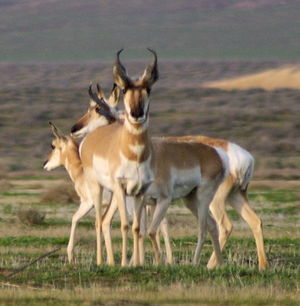|
June 12, 2007
PLANNING PROCESS RESUMES FOR
CARRIZO PLAIN NATIONAL MONUMENT
Process Will Guide Land Use Decisions on the
National Monument for Next Decade; ForestWatch
Demands Strong Protections for California's "Serengeti"
San Luis Obispo Co., Calif. -
The U.S. Bureau of Land Management recently resumed the planning
process for the Carrizo Plain National Monument in southeastern
San Luis Obispo County, adjacent to the Los Padres National
Forest. After a series of controversies, efforts are now
underway to prepare a Resource Management Plan (RMP) for the
monument to guide the stewardship of this area for the next
decade. The RMP offers a unique opportunity to produce a
comprehensive long-range vision for management of this
ecologically sensitive area.
This week, ForestWatch and a
broad coalition of conservation groups submitted a series of
detailed recommendations to the BLM, urging the federal agency
to adopt a strong and scientifically-based management plan for
the monument. The letter was submitted as part of the "scoping"
process, an early opportunity for the public to submit ideas and
recommendations for the management of the Carrizo Plain. The
scoping period closed on June 12, 2007.
The Carrizo Plain National
Monument was established by Presidential Proclamation in 2001.
Located in the southeastern portion of San Luis
Obispo County and parts of southwestern Kern County, the
250,000-acre Carrizo Plain National Monument encompasses the
largest relatively intact remnant of ecosystems that once
characterized the southern San Joaquin Valley. "Full of natural
splendor and rich in human history," states the Proclamation,
"the majestic grasslands and stark ridges in the Carrizo Plain
National Monument contain exceptional objects of scientific and
historic interest...providing crucial habitat for the longterm
conservation of the many endemic plant and animal species that
still inhabit the area."
 The
Carrizo Plain is home to thirteen species of plants and animals
that are listed as threatened or endangered, including the San
Joaquin kit fox, the blunt-nosed leopard lizard, the San Joaquin
antelope squirrel, California condor, and California jewelflower.
The area is also home to reintroduced herds of pronghorn
antelope and Tule elk, previously hunted to extinction in the
late 1800s. The
Carrizo Plain is home to thirteen species of plants and animals
that are listed as threatened or endangered, including the San
Joaquin kit fox, the blunt-nosed leopard lizard, the San Joaquin
antelope squirrel, California condor, and California jewelflower.
The area is also home to reintroduced herds of pronghorn
antelope and Tule elk, previously hunted to extinction in the
late 1800s.
Soda Lake, the centerpiece of
the Carrizo Plain, glistens within a vast open grassland. The
area is also rich in Native American cultural values. Painted
Rock, a sacred, ceremonial site of the Chumash People, rises
majestically from the grassland while remnants of homesteads,
farms and mining operations dot the remainder of the plain.
Several years ago, after the
monument was established, the BLM began preparing an Resource
Management Plan. However, attempts by field managers to
strengthen the plan were thwarted by BLM bureaucrats, who
pressured field managers to allow more resource extraction at
the expense of wildlife and other monument values. In May 2005,
Marlene Braun, the manager of the Carrizo Plain National
Monument, killed herself, leaving a suicide note citing abuse,
humiliation, and unprofessional conduct by her chain-of-command.
A subsequent Inspector General "Report of Investigation"
released last year found that "a breakdown in trust,
communication and cooperation...adversely affected management of
the Carrizo Plains."
Towards the end of last year,
the planning process changed direction after ForestWatch and
other groups working to protect the Carrizo Plain voiced their
concerns. In response, BLM agreed to resume the planning
process, expanding the effort to include a more comprehensive
Environmental Impact Statement and providing additional
opportunities for public input and scientific scrutiny.
The groups submitting the
recent recommendations include The Wilderness Society, Los
Padres ForestWatch, California Wilderness Coalition, Center for
Biological Diversity, Sierra Club, Western Watersheds Project,
Defenders of Wildlife, Californians for Western Wilderness, and
the Natural Resources Defense Council. In addition, more than
3,000 individuals submitted comments to the BLM demanding strong
protections for the Carrizo Plain.
WHAT'S NEXT
The scoping comment period
closed on June 12, 2007. The BLM will review all comments
received and post a summary of those comments in late June.
Based on these comments, the BLM will prepare a draft Resource
Management Plan and a draft environmental impact statement. Both
of these documents will be released for public review in early
2008, according to the BLM. The agency hopes to finalize the
management plan in Fall 2008. Public meetings will be scheduled
during this time to gather additional input. |